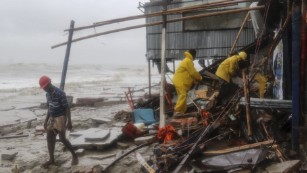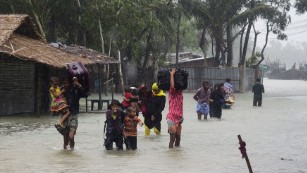Tropical Cyclone Roanu lashed the coast of Bangladesh with heavy winds and sheets of rain, killing at least 21 people and forcing the evacuation of half a million residents, authorities said.
With 55 mile-per-hour winds and downpours of more than a foot in some areas on Saturday, the cyclone hit the south and southeast regions of Barisal and Chittagong especially hard — damaging hundreds of houses and causing landslides, according to disaster officials.

Roanu made landfall Saturday and began to weaken as it roared over Bangladesh, according to CNN meteorologist Allison Chinchar.
In the days before it touched down, the cyclone dumped 9 to 13 inches of rain in parts of Bangladesh and more than 18 inches in Kakinada, India, more than 800 miles away.
Parts of Bangladesh could see additional accumulations ranging from 2 to 6 inches, according to Chinchar.
“We’ve confirmed 21 deaths in six districts so far,” Dalil Uddin, a representative of the disaster management ministry, told CNN.
Uddin said many fatalities involved people who were buried under uprooted trees, damaged houses and landslides. The death toll was expected to rise.
Vast swaths of land in coastal cities were inundated and some 500,000 people were evacuated to shelters, Mofazzal Hossain Chowdhury, minister of disaster management and relief, told reporters.

The storm disrupted power and road communications in many parts of the country, officials said.
Its sea level geography and location have conspired to make Bangladesh vulnerable to cyclones.
In 1991, a cyclone killed at least 140,000 people, according to the United Nations.
In 1970, Cyclone Bhola struck Bangladesh, then East Pakistan, killing 500,000 people. The U.S. National Oceanic and Atmospheric Administration called the storm the 20th century’s “greatest tropical system disaster.”
Since then, improved warning systems and shelters have helped reduce the number of deaths during more recent storms.
As reported by CNN
